Hyperpigmentation
| Hyperpigmentation | |
|---|---|
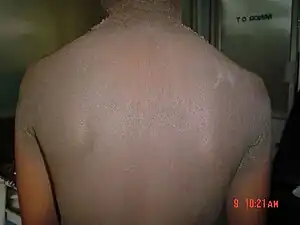 | |
| Specialty | Dermatology |
| Causes | Melanogenesis |
Hyperpigmentation is the darkening of an area of skin or nails caused by increased melanin.
Signs and symptoms
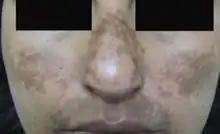 Melasma
Melasma Macular amyloidosis
Macular amyloidosis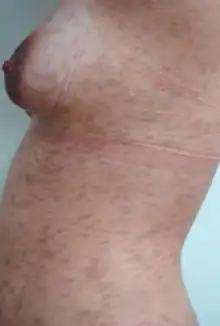 Postinflammatory hyperpigmentation
Postinflammatory hyperpigmentation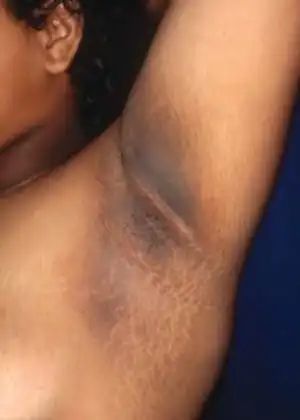 Acanthosis nigricans
Acanthosis nigricans Erythema Dyschromicum Perstans
Erythema Dyschromicum Perstans Poikiloderma of Civatte
Poikiloderma of Civatte Phytophotodermatoses
Phytophotodermatoses Flagellate Dermatitis
Flagellate Dermatitis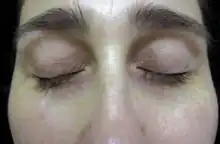 Periorbital hyperpigmentation
Periorbital hyperpigmentation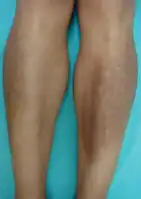 Amyloid lichen.
Amyloid lichen.
Causes
Hyperpigmentation can be caused by sun damage, inflammation, or other skin injuries, including those related to acne vulgaris.[1][2][3]: 854 People with darker skin tones are more prone to hyperpigmentation, especially with excess sun exposure.[4]
Many forms of hyperpigmentation are caused by an excess production of melanin.[4] Hyperpigmentation can be diffuse or focal, affecting such areas as the face and the back of the hands. Melanin is produced by melanocytes at the lower layer of the epidermis. Melanin is a class of pigment responsible for producing color in the body in places such as the eyes, skin, and hair. The process of melanin synthesis (melanogenesis) starts with the oxidation of l-tyrosine to l-dopa by the enzyme tyrosine hydroxylase, then to l-dopaquinone and dopachrome, which forms melanin.[5]
As the body ages, melanocyte distribution becomes less diffuse and its regulation less controlled by the body. UV light stimulates melanocyte activity, and where concentration of the cells is greater, hyperpigmentation occurs. Another form of hyperpigmentation is post-inflammatory hyperpigmentation. These are dark and discoloured spots that appear on the skin following acne that has healed.[6]
Diseases and conditions
Hyperpigmentation is associated with a number of diseases or conditions, including the following:
- Addison's disease and other sources of adrenal insufficiency, in which hormones that stimulate melanin synthesis, such as melanocyte-stimulating hormone (MSH), are frequently elevated.
- Cushing's disease or other excessive adrenocorticotropic hormone (ACTH) production, because MSH production is a byproduct of ACTH synthesis from proopiomelanocortin (POMC).
- Acanthosis nigricans—hyperpigmentation of intertriginous areas associated with insulin resistance.
- Melasma, also known as 'chloasma' or the “mask of pregnancy,” when it occurs in pregnant women.— It is a common skin problem that causes dark discolored patchy hyperpigmentation. It typically occurs on the face and is symmetrical, with matching marks on both sides of the face. The condition is much more common in women than men, though men can get it too. According to the American Academy of Dermatology, 90 percent of people who develop melasma are women.[7]
- Post-Acne marks from post-inflammatory hyperpigmentation.
- Linea nigra—a hyperpigmented line found on the abdomen during pregnancy.
- Peutz–Jeghers syndrome—an autosomal dominant disorder characterized by hyperpigmented macules on the lips and oral mucosa and gastrointestinal polyps.
- Exposure to certain chemicals such as salicylic acid, bleomycin, and cisplatin.
- Smoker's melanosis
- Coeliac disease
- Cronkhite–Canada syndrome
- Porphyria
- Tinea fungal infections such as ringworm.
- Haemochromatosis—a common but debilitating genetic disorder characterized by the chronic accumulation of iron in the body.
- Mercury poisoning—particularly cases of cutaneous exposure resulting from the topical application of mercurial ointments or skin-whitening creams.
- Aromatase deficiency
- Nelson's syndrome
- Graves' disease
- Schimke immunoosseous dysplasia (SOID).[8]
- As a result of tinea cruris.
- Due to B12 deficiency.[9]
- Atopic dermatitis as a result of inflammation.[10]
Hyperpigmentation can sometimes be induced by dermatological laser procedures.
Diagnosis
- A physical examination including, Wood's lamp examination and a detailed history, usually sufficient for diagnosis.
- Skin examination.
- Viewing medical history.
Treatment
There are a wide range of depigmenting treatments used for hyperpigmentation conditions, and responses to most are variable.[11]
Most often treatment of hyperpigmentation caused by melanin overproduction (such as melasma, acne scarring, liver spots) includes the use of topical depigmenting agents, which vary in their efficacy and safety, as well as in prescription rules.[12]
Topical treatments
Many topical treatments disrupt the synthesis of melanin by inhibiting the enzyme tyrosine hydroxylase.[5]
Several are prescription only in the US, especially in high doses, such as hydroquinone, azelaic acid,[13] and kojic acid.[14] Some are available without prescription, such as niacinamide,[15][16] l-ascorbic acid, retinoids such as tretinoin,[17] or cysteamine hydrochloride.[18][19] Hydroquinone was the most commonly prescribed hyperpigmentation treatment before the long-term safety concerns were raised,[20] and the use of it became more regulated in several countries and discouraged in general by WHO.[21] For the US, only 2% is at present sold over-the-counter, and 4% needs prescription. In the EU hydroquinone was banned from cosmetic applications.[22] According to leading Celebrity Dermatologist Dr. Chytra Anand, active ingredients such as Licorice, Malic acid, Glycolic & Lactic acid, Niacinamide, Vitamin C & Turmeric in a daily skin care routine can also help reduce pigmentation.[23]
Oral
Oral medication with procyanidin plus vitamins A, C, and E also shows promise as safe and effective for epidermal melasma. In an 8-week randomized, double-blind, placebo-controlled trial in 56 Filipino women, treatment was associated with significant improvements in the left and right malar regions, and was safe and well tolerated.[24] Other treatments that do not involve topical agents are also available, including fraction lasers[25] and dermabrasion.[12]
Laser treatments
Laser toning using YAG lasers[26] and intense pulsed light have been used to treat hyperpigmentation such as melasma and post-inflammatory hyperpigmentation.[27]
See also
References
- ↑ "Hyperpigmentation". Dermatalogic Disease Database. American Osteopathic College of Dermatology. Archived from the original on 2002-02-13. Retrieved 2006-03-08.
- ↑ Rapini, Ronald P.; Bolognia, Jean L.; Jorizzo, Joseph L. (2007). Dermatology: 2-Volume Set. St. Louis: Mosby. ISBN 978-1-4160-2999-1.
- ↑ James, William; Berger, Timothy; Elston, Dirk (2005). Andrews' Diseases of the Skin: Clinical Dermatology. (10th ed.). Saunders. ISBN 0-7216-2921-0.
- 1 2 Chandra, M; Levitt, J; Pensabene, CA (May 2012). "Hydroquinone therapy for post-inflammatory hyperpigmentation secondary to acne: not just prescribable by dermatologists". Acta Dermato-Venerologica. 92 (3): 232–5. doi:10.2340/00015555-1225. PMID 22002814.
- 1 2 Kim, Ji Hye; Kang, Nam Joo (2015-07-14). "Potent whitening effects of rutin metabolites". Korean Journal of Food Preservation (in Latina). 22 (4): 607–612. doi:10.11002/kjfp.2015.22.4.607. ISSN 2287-7428. Archived from the original on 2022-08-15. Retrieved 2022-03-15.
- ↑ Hyperpigmentation on Face (Acne Scars) Archived 2023-03-06 at the Wayback Machine Hyperpigmentation, Dark Spots, Acne Scars, Meladerm.
- ↑ "Melasma". American Academy of Dermatology, Inc. Archived from the original on 2016-03-01. Retrieved 2023-01-29.
- ↑ "Schimke immunoosseous dysplasia | Genetic and Rare Diseases Information Center (GARD) – an NCATS Program". rarediseases.info.nih.gov. Archived from the original on 2017-10-25. Retrieved 2019-03-13.
- ↑ Kannan, R.; Ng, M. J. (2008). "Cutaneous lesions and vitamin B12 deficiency: An often-forgotten link, Rajendran Kannan, MB BS MD". Canadian Family Physician. 54 (4): 529–532. PMC 2294086. PMID 18413300.
- ↑ Lawrence, Elizabeth; Al Aboud, Khalid M. (2022), "Postinflammatory Hyperpigmentation", StatPearls, Treasure Island (FL): StatPearls Publishing, PMID 32644576, archived from the original on 2022-03-16, retrieved 2022-03-27
- ↑ Gupta, AK; Gover, MD; Nouri, K; Taylor, S (December 2006). "The treatment of melasma: a review of clinical trials". Journal of the American Academy of Dermatology. 55 (6): 1048–65. doi:10.1016/j.jaad.2006.02.009. PMID 17097400.
- 1 2 "Variety of options available to treat pigmentation problems | American Academy of Dermatology". www.aad.org. Archived from the original on 2017-02-13. Retrieved 2017-02-12.
- ↑ Mazurek, Klaudia; Pierzchała, Ewa (2016-09-01). "Comparison of efficacy of products containing azelaic acid in melasma treatment". Journal of Cosmetic Dermatology. 15 (3): 269–282. doi:10.1111/jocd.12217. ISSN 1473-2165. PMID 27028014. S2CID 25303091.
- ↑ Monteiro, Rochelle C.; Kishore, B. Nanda; Bhat, Ramesh M.; Sukumar, D.; Martis, Jacintha; Ganesh, H. Kamath (2013-03-01). "A Comparative Study of the Efficacy of 4% Hydroquinone vs 0.75% Kojic Acid Cream in the Treatment of Facial Melasma". Indian Journal of Dermatology. 58 (2): 157. doi:10.4103/0019-5154.108070. ISSN 1998-3611. PMC 3657227. PMID 23716817.
- ↑ Hakozaki, T.; Minwalla, L.; Zhuang, J.; Chhoa, M.; Matsubara, A.; Miyamoto, K.; Greatens, A.; Hillebrand, G.G.; Bissett, D.L. (2002-07-01). "The effect of niacinamide on reducing cutaneous pigmentation and suppression of melanosome transfer". British Journal of Dermatology. 147 (1): 20–31. doi:10.1046/j.1365-2133.2002.04834.x. PMID 12100180. S2CID 39489580.
- ↑ "Spotlight On: Niacinamide - FutureDerm". FutureDerm. 2007-10-30. Archived from the original on 2017-02-13. Retrieved 2017-02-12.
- ↑ Callender, Valerie D.; Baldwin, Hilary; Cook-Bolden, Fran E.; Alexis, Andrew F.; Stein Gold, Linda; Guenin, Eric (2021-11-09). "Effects of Topical Retinoids on Acne and Post-inflammatory Hyperpigmentation in Patients with Skin of Color: A Clinical Review and Implications for Practice". American Journal of Clinical Dermatology. Springer Science and Business Media LLC. 23 (1): 69–81. doi:10.1007/s40257-021-00643-2. ISSN 1175-0561. PMC 8776661. PMID 34751927.
- ↑ Mansouri, P.; Farshi, S.; Hashemi, Z.; Kasraee, B. (2015-07-01). "Evaluation of the efficacy of cysteamine 5% cream in the treatment of epidermal melasma: a randomized double-blind placebo-controlled trial". The British Journal of Dermatology. 173 (1): 209–217. doi:10.1111/bjd.13424. ISSN 1365-2133. PMID 25251767. S2CID 21618233.
- ↑ "Cysteamine Cream® -- New Hyper Intensive Depigmenting Treatment". Scientis Pharma. Archived from the original on 2016-12-24. Retrieved 2017-02-12.
- ↑ Draelos, Zoe Diana (2007-09-01). "Skin lightening preparations and the hydroquinone controversy". Dermatologic Therapy. 20 (5): 308–313. doi:10.1111/j.1529-8019.2007.00144.x. ISSN 1529-8019. PMID 18045355. S2CID 24913995.
- ↑ Hyrdoquinone Guidance published under the joint sponsorship of the United Nations Environment Programme, the International Labour Organisation, and the World Health Organization. World Health Organization. 1994. hdl:10665/39218. ISBN 9789241571579.
- ↑ "Hydroquinone - Substance evaluation - CoRAP - ECHA". echa.europa.eu. Archived from the original on 2017-02-13. Retrieved 2017-02-12.
- ↑ "Glow Brite Beauty Box - Best Kit for Pigmentation". skinq.com. Archived from the original on 2022-12-26. Retrieved 2022-12-26.
- ↑ Handog, Evangeline (2009-07-20). "A randomized, double-blind, placebo-controlled trial of oral procyanidin with Vitamins A, C, E for melasma among Filipino women". International Journal of Dermatology. 48 (8): 896–901. doi:10.1111/j.1365-4632.2009.04130.x. PMID 19659873. S2CID 28886093.
- ↑ "Laser Skin Whitening - Advantages and Disadvantages | Skin Whitening News". skinwhiteningnews.org. 2014-04-05. Archived from the original on 2021-09-19. Retrieved 2017-02-12.
- ↑ Kim, Young Jae; Suh, Hyun Yi; Choi, Myoung Eun; Jung, Chang Jin; Chang, Sung Eun (2020-04-17). "Clinical improvement of photoaging-associated facial hyperpigmentation in Korean skin with a picosecond 1064-nm neodymium-doped yttrium aluminum garnet laser". Lasers in Medical Science. Springer Science and Business Media LLC. 35 (7): 1599–1606. doi:10.1007/s10103-020-03008-z. ISSN 0268-8921. PMID 32300974. S2CID 215794622.
- ↑ Arora, Pooja; Sarkar, Rashmi; Garg, Vijay K; Arya, Latika (2022-01-27). "Lasers for Treatment of Melasma and Post-Inflammatory Hyperpigmentation". Journal of Cutaneous and Aesthetic Surgery. 5 (2): 93–103. doi:10.4103/0974-2077.99436. PMC 3461803. PMID 23060704.
External links
| Classification |
|---|